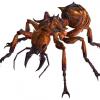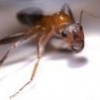The Pogonomyrmex subnitidus colonies near here don't even get attacked as far as I can tell from Argentine ants. Though they are limited to the dry sandy areas of the partly man-made canal...the Argentine ants leave them all alone. In fact, one colony (numbering about 10,000) was right next to a HUGE Argentine ant colony a couple feet away and they were still left alone.
Though the Pogonomyrmex do get attacked in areas that contain dirt and get wiped out. One P. subnitidus colony got killed by Argentine ants sometime last year, and it was in an area with only hard dirt. It was a much smaller colony though, not a huge one. So that probably played a part.
Now another example of this is down at Torrey Pines State Beach in San Diego (TONS of native ants there up in the trails, except its a heavily patrolled state park...I did sneak a Formica ant queen out (amazing Formica colony out of her) and some Pogonomyrmex queens  ). The Pogonomyrmex californicus colonies started spreading all the way down toward the beach, where Argentine ants dominate (or used to, their numbers were less and less every year...probably even less now). And Argentine ants completely disappeared by the bathrooms on top of the park where the trails are. Except, the Pogonomyrmex mostly dominated in the sandy areas. Anywhere with dirt, the Argentine ants kept them away.
). The Pogonomyrmex californicus colonies started spreading all the way down toward the beach, where Argentine ants dominate (or used to, their numbers were less and less every year...probably even less now). And Argentine ants completely disappeared by the bathrooms on top of the park where the trails are. Except, the Pogonomyrmex mostly dominated in the sandy areas. Anywhere with dirt, the Argentine ants kept them away.
However, I DID see Argentine ants at Torrey Pines swarming into a Pogonomyrmex nest by the 10s of thousands. A month later, same Pogonomyrmex colony was active and doing really good and the Argentine ants were avoiding them or gone.
Which leads me to believe that either Pogonomyrmex do AMAZING at defense in sandy areas and poorly in areas with dirt, or/and Argentine ants fail at attacking and defeating Pogonomyrmex in sandy areas. Or/and (again) Pogonomyrmex colonies that nest REALLY deep and are large numbers do much better against Argentine ants. Or/and (and again) because Argentine ants are disappearing in areas, Pogonomyrmex are finding better success against Argentine ants.
Because the river here, millions of Argentine ants by the Pogonomyrmex. Literally there is SO many Argentine ants. Yet, the Pogonomyrmex subnitidus have colonies all up/down a large section of river and either never get attacked at all...or the Argentine ants can't get into their sandy nests.
Its also possible, like the Prenolepis imparis ant evolved to defeat Argentine ants...that Pogonomyrmex as a genus, overall, as learned/evolved over the years to either defeat Argentine ants or learned to deal with them from destroying their nest. Because before I moved from San Diego, the Pogonomyrmex californicus who used to be owned and annihilated by Argentine ants started finding huge success against them. Granted, Argentine ants started disappearing about the same time...so could be a whole bunch of combination of things.






















